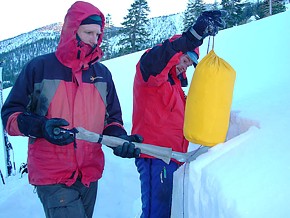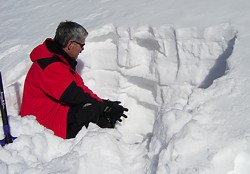For your own safety, take an Avalanche Safety Course.

The Stuffblock Test
Snowpack stability tests are important tools for backcountry travelers trying to evaluate the stability of a particular slope. Although numerous stability tests currently exist, all of them have shortcomings.
The properties desired in a so-called "ideal" test are:
A relatively new and increasingly popular test is the stuffblock test. The stuffblock, developed over several seasons at the Gallatin National Forest Avalanche Center, is used operationally for avalanche forecasting in southwest Montana.
The test consists of: 1) isolating a small block of snow on an inclined slope, and 2) dropping a nylon sack full of a known mass of snow onto the block from varying heights until the weak layer fails.
While the stuffblock may not be the perfect stability test, it does have many desirable attributes: it is simple to learn, it is reasonably fast, required equipment is field portable and inexpensive, it can be applied equally by skiers, snowboarders and snowmobilers, and it provides numerical results that are easily compared between observers and test sites.
Our results indicate a positive statistical relationship between stuffblock results and the more time-consuming rutschblock test. Thus, the stuffblock is another useful tool for avalanche workers and backcountry recreationalists attempting to evaluate slope stability.

The equipment required to perform the stuffblock test is easy to acquire, inexpensive, and lightweight. The necessary tools include a snow shovel (a flat bladed shovel works best), a snow saw (not essential, but helps for consistent isolated columns), a nylon stuff sack, a scale (capable of measuring 4.5 kg (10 lbs)), and a nylon cord.
Since most avalanche workers and many backcountry skiers carry shovels and saws in the field, typically only the stuff sack, scale, and cord need to be added to a snow pit kit. These can all be purchased at a sporting goods store for less than $20, and they only weigh about 0.5 kg (1 lb).
The scales we used for the test are used to weigh fish and cost about $10. The nylon cord should be about 0.80 m long, and needs to be marked off in 0.10 m increments. By attaching the cord to the bottom of the stuff sack, drop heights can be easily determined.
The procedure for conducting a stuffblock test is straightforward and does not require extensive snow removal from the snow pit wall:
An important part of any stability test is to maintain consistency in the testing procedure, and the stuffblock is no exception. To ensure dependable results, the isolated column of snow should have vertical sides and a uniform shape, the shovel blade should be held horizontally with the tip of the blade resting on the upslope side, and the stuff sack should be dropped onto the middle of the shovel blade.
We find that performing a stuffblock test adds only a few minutes to the total amount of time spent analyzing the snowpack in a given snow pit. In fact, once the stuff sack is filled with snow, it is easy to perform several stuffblock tests in the same snow pit. Performing several tests analyzes a larger area of snow and helps to validate the results for a particular location.

The stuffblock test supplies valuable snow stability information. In general, higher drop heights are associated with more stable conditions on slopes of similar elevation, aspect, and slope angle.
As a loose guideline, drop heights of about 0 to 0.20 m indicate mostly unstable snowpack conditions, 0.30 to 0.50 m indicate moderately stable snowpack conditions, and drop heights exceeding 0.50 m indicate the snowpack is mostly stable.
However, results from the stuffblock test, like all stability tests, are not definitive and simply provide one more piece of information for a forecaster or backcountry traveler to contemplate when evaluating the stability of a slope.
While the stuffblock test may not be perfect, it is an effective snow stability test. The stuffblock meets many of the goals set forth for an ideal test, including simplicity, speed, and portability. It can be used by all backcountry recreationalists, including skiers, snowmobilers and snowboarders. Overall, the stuffblock test provides backcountry skiers and avalanche workers with an inexpensive and portable means of assessing snowpack stability.
Acknowledgements
We would like to thank the National Avalanche Center, which provided monetary support for this project, and the Gallatin National Forest, which allowed us to experiment with this test for several seasons.
For a more detailed article on the stuffblock test download PDF version or click here. For more avalanche related articles visit Gallatin National Forest Avalanche Center.
Karl Birkeland and Ron Johnson work as forecasters for the Gallatin National Forest Avalanche Center in Montana.